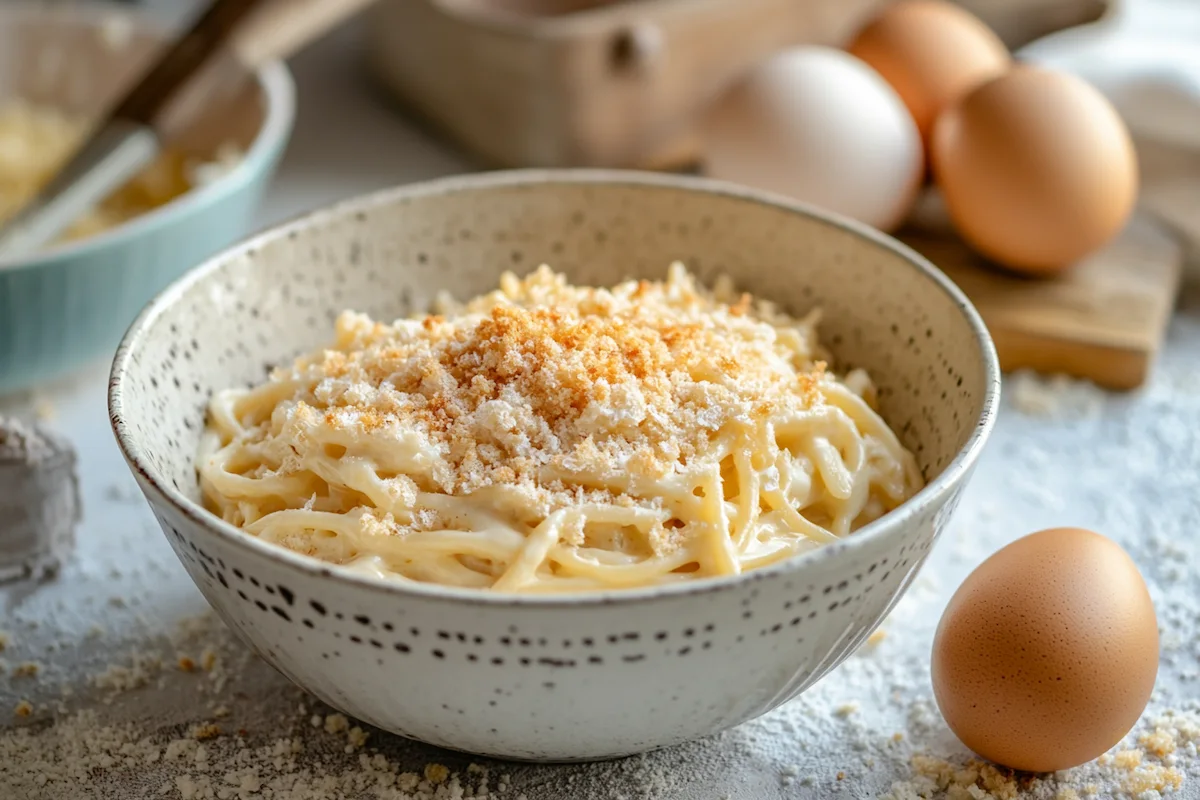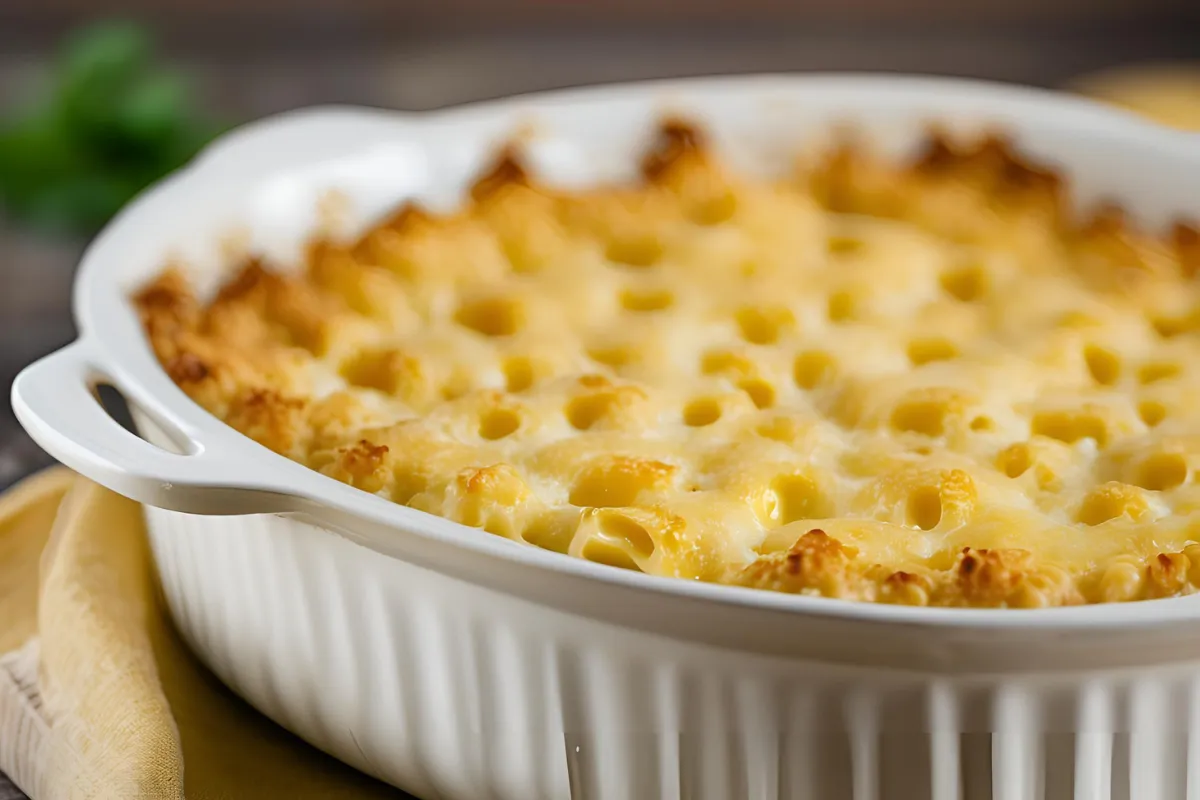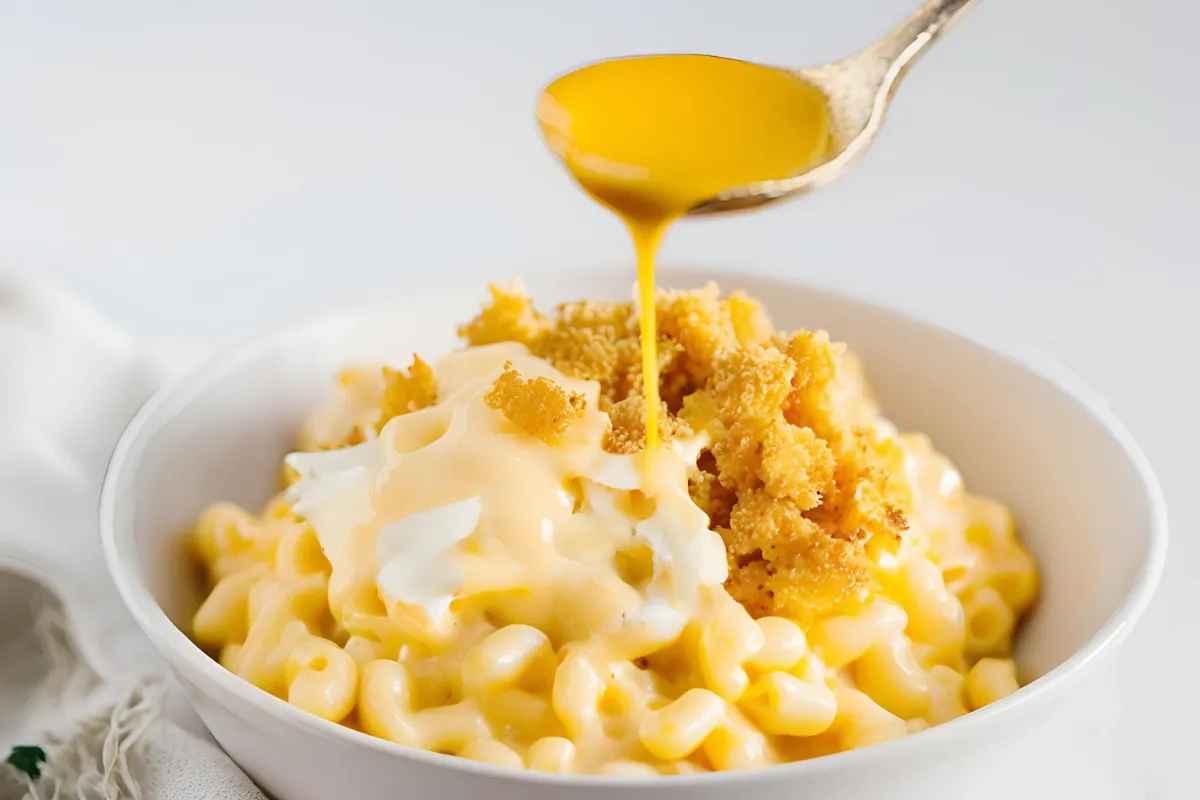Introduction
Egg in Mac and Cheese is a topic that sparks curiosity among food lovers. This classic comfort dish, cherished for its creamy, cheesy goodness, can reach new levels of flavor and texture with the addition of eggs. But what exactly does egg do for mac and cheese? The answer lies in its ability to add richness, bind the ingredients, and create a velvety smooth texture.
In this article, we’ll dive into the role of eggs in mac and cheese, explore how they transform the dish, and even discuss when and how to use alternatives. Get ready to elevate your mac and cheese game!
Eggs in Mac and Cheese: Overview
What Does Egg Do for Mac and Cheese?
Eggs may not be the first ingredient you think of for mac and cheese, but they make a big difference. Whether added to the cheese sauce or mixed with the pasta, eggs contribute more than nutrition.
Some people prefer egg-free mac and cheese, but eggs are a key ingredient in many recipes. They enhance texture, richness, and cohesiveness. Eggs tie everything together, adding a subtle savory richness that elevates the creamy texture.
The Importance of Egg in Cooking
Eggs are widely regarded as one of the most versatile ingredients in the kitchen, playing an essential role in everything from baking to savory dishes. Why? Well, eggs act as binding agents, emulsifiers, and thickeners. So, in mac and cheese, eggs help bring everything together—ensuring your cheese sauce doesn’t separate and your pasta stays coated evenly.
In fact, eggs can even transform a watery, runny cheese sauce into something more substantial. They work their magic by creating a smooth, creamy texture, allowing the flavors to mingle seamlessly. It’s no wonder that many mac and cheese enthusiasts swear by them.
The Science Behind Adding Eggs to Mac and Cheese
How Does Egg Affect the Texture of Mac and Cheese?
When it comes to mac and cheese, the texture is everything. You want that perfect balance between creamy, cheesy sauce and tender pasta. That’s where the magic of eggs in mac and cheese comes into play.
Eggs are a key binding agent in mac and cheese. Without them, the cheese sauce slides off the pasta. Eggs help the sauce stick, creating a smooth, cohesive dish. Every bite stays coated in cheesy goodness. That’s why mac and cheese holds together so well when you use eggs.
Eggs also contribute significantly to the creaminess of the dish. The proteins in eggs break down as they cook, creating a smooth, velvety texture that helps the sauce coat the pasta without feeling too thick or lumpy. This creamy consistency is what makes your mac and cheese feel indulgent and rich. Without the eggs, the sauce can often feel grainy or uneven—definitely not the smooth, comforting dish you crave.
Another benefit of adding eggs is that they help prevent separation or curdling in your cheese sauce. When cheese sauce is cooked at high temperatures or for too long, it can separate into oily, greasy clumps. But when eggs are added, they help stabilize the mixture. The proteins in eggs interact with the cheese and the fats in the sauce, ensuring that the sauce stays emulsified and doesn’t break apart into an oily mess.
Egg as a Thickening Agent
Eggs are also excellent at thickening the cheese sauce. This is where the science gets a little more interesting. When eggs are heated, the proteins inside them undergo a chemical reaction, causing them to coagulate and thicken the sauce. This process is what transforms a thin, watery cheese sauce into something rich and creamy.
As the eggs cook, they trap moisture and fat, thickening the overall consistency of the sauce. Not only does this give the sauce a more luxurious texture, but it also enhances the richness of the dish. The result is a velvety, smooth sauce that clings to the pasta like a dream. If you’ve ever had mac and cheese that felt a little too runny, it’s likely because there wasn’t enough of that egg thickening action happening.
Egg in Mac and Cheese: Preventing the Sauce from Being Watery
We’ve all been there—mac and cheese that turns out a bit too watery or thin. But don’t worry, adding eggs is a surefire way to avoid this issue. The reason some mac and cheese dishes become runny is that the cheese sauce can’t hold its consistency, especially if you’re using a lot of milk or cream.
Eggs act as an emulsifier—they help the fat in the cheese and the liquid in the sauce come together. Without eggs, the fats in the cheese can separate from the milk, causing the sauce to become watery. But with eggs, the proteins work to hold everything together, giving the sauce a rich, creamy consistency that doesn’t separate.
By incorporating eggs into your mac and cheese, you can easily achieve that perfect balance of creamy and thick without worrying about a watery mess. So next time you’re making mac and cheese, remember that eggs don’t just contribute flavor; they’re crucial for maintaining the texture and consistency you love.
Flavor Enhancement with Egg in Mac and Cheese
The Subtle Flavor Egg Brings to Mac and Cheese
When you add eggs to mac and cheese, they do more than just influence the texture—they also enhance the overall flavor of the dish. While cheese is the star of the show, eggs act as a subtle flavor enhancer, helping to balance the richness of the cheese sauce. Cheese, especially rich varieties like cheddar or Gruyère, can sometimes be a bit overpowering. This is where eggs step in.
Eggs bring a delicate savory note to the dish, softening the sharpness of the cheese and helping to round out the flavor. It’s like a background note that ties everything together, without drawing too much attention to itself. Imagine the dish as a symphony, and the egg is the gentle conductor that ensures all the flavors come together harmoniously. It doesn’t dominate the palate; instead, it elevates the existing flavors, making each bite feel just right.
In addition to balancing the richness, eggs also contribute to the smoothness of the flavor. Without eggs, the sauce might feel a little one-dimensional or overly greasy, but with eggs, it takes on a more nuanced, complex profile. They help elevate mac and cheese from just a simple cheesy dish to something that feels full-bodied and satisfying.
Egg’s Role in Customizing Mac and Cheese Recipes
One of the fun things about adding eggs to your mac and cheese is how they work in tandem with different types of cheese, allowing for a wide variety of flavor profiles. If you’re a fan of sharp, tangy cheese, like aged cheddar, eggs will help balance that sharpness, giving you a richer, more cohesive flavor. On the other hand, if you prefer milder cheeses like mozzarella, the eggs will bring a creaminess and fullness to the dish that enhances the cheese’s subtle taste.
Varying the type of egg used—whether it’s a whole egg or just the egg yolk—can also have a significant impact on the flavor. Egg yolks, for example, add a bit more richness and a deeper, almost buttery flavor, while whole eggs provide a more balanced effect, contributing both richness and structure. Whether you stick to one variety or experiment with different types of cheese and egg combinations, eggs allow for endless customization in your mac and cheese.
Creating a Perfectly Balanced Mac and Cheese Flavor with Egg
Eggs are often the unsung hero in mac and cheese, not just because they influence the texture, but also because they help create the perfect balance of flavors. They act as a base ingredient that unites the cheese, pasta, and other ingredients, ensuring that no single element dominates the dish. Without the egg, the mac and cheese might taste too heavy or too greasy, but with it, everything comes together in a rich, smooth symphony of flavor.
Achieving that just right level of flavor without overwhelming the dish is an art—and eggs are the key to mastering it. By adding eggs, you create a flavor profile that is both savory and creamy, enhancing the cheese without overshadowing it. The result? A perfectly balanced mac and cheese that leaves you craving more.
Variations and Alternatives to Egg in Mac and Cheese
Mac and Cheese Recipes Without Eggs: What Happens?
If you’re wondering whether it’s possible to make mac and cheese without eggs, the answer is yes! However, omitting eggs will definitely change the texture and flavor of the dish. Without eggs, the cheese sauce tends to be a bit thinner, and it may not coat the pasta as well. The creamy, smooth texture that eggs help achieve might be lost, leaving the sauce a little more runny or even greasy. This can result in a less cohesive dish, where the cheese sauce doesn’t bind well with the pasta, and it can separate during baking.
Flavor-wise, you may miss that subtle savory depth that eggs provide. While you’ll still enjoy the sharpness and richness of the cheese, the overall flavor might feel a bit more one-dimensional. Eggs help round out the flavor profile by adding a slight richness that balances the acidity of the cheese, and without them, the dish may not taste as rich or satisfying. But don’t worry—many people still enjoy egg-free mac and cheese and find that it has its own charm.
Some people also prefer to skip eggs for dietary reasons, like avoiding cholesterol or following a vegan lifestyle. It’s worth noting that many who choose to omit eggs still achieve a creamy texture and satisfying flavor using other methods. But if you’re looking for that signature creaminess and richness that eggs provide, you might want to reconsider skipping them entirely.
Alternative Ingredients to Replace Egg in Mac and Cheese
If you’re looking for alternatives to eggs, there are several great options—both for dairy lovers and those following plant-based diets. Let’s take a look at some of the most popular choices:
- Dairy alternatives: If you still want that creamy texture but prefer to avoid eggs, you can substitute them with other dairy products like cream cheese, sour cream, or heavy cream. These ingredients can mimic the rich, velvety texture that eggs provide, and in many cases, they’ll even enhance the creaminess of the sauce. Cream cheese, for example, adds a tangy richness, while sour cream offers a subtle sharpness that balances out the flavors beautifully.
- Vegan replacements: For those who prefer a vegan or egg-free option, there are plenty of plant-based substitutions that can create a similar texture and flavor. Tofu works well as a thickener when blended into the sauce, while nutritional yeast adds that cheesy, savory flavor that’s often missing in dairy-free versions. You can also use plant-based milks like almond or soy milk to add creaminess without relying on dairy or eggs.
Each of these alternatives brings something unique to the table. Whether you’re looking for a rich, creamy texture or a dairy-free solution, there’s a replacement out there to suit your needs.
Is Egg Essential for All Mac and Cheese Recipes?
While eggs are a common and essential ingredient in many traditional mac and cheese recipes, they’re not absolutely necessary in every variation. Depending on the recipe and the desired outcome, you may find that you can create an equally delicious mac and cheese without eggs.
Some mac and cheese recipes skip eggs entirely, using other techniques to create a creamy texture. A roux, made with flour and butter, thickens the sauce. Extra cheese or cream can boost richness. Some cheese combinations, like Gruyère or fontina, melt smoothly, making eggs unnecessary.
Ultimately, whether or not to include eggs in your mac and cheese depends on personal preference, dietary restrictions, and the texture and flavor you’re aiming for. Eggs can enhance the creaminess and flavor, but they’re not the only way to achieve a rich, satisfying dish. It’s all about experimenting and finding the right balance for your tastes.
FAQs Section
Can you make mac and cheese without an egg?
Yes, you can make mac and cheese without eggs! There are alternatives that achieve similar creamy results. Dairy like cream cheese, sour cream, or heavy cream can help. Plant-based options like tofu or nutritional yeast also mimic eggs’ richness. Without eggs, the texture may be slightly different, and the sauce could be runnier. Still, it will be delicious!
Why does my mac and cheese get watery? Does egg help?
Mac and cheese can become watery for several reasons, such as too much liquid in the sauce or undercooked cheese. Without eggs, the sauce may not emulsify properly, causing the fat in the cheese to separate and create a watery mess. Eggs help bind the sauce together and prevent separation, giving the dish a richer, thicker consistency. So yes, eggs can definitely help prevent watery mac and cheese by acting as an emulsifier.
Can I use egg as a thickener for mac and cheese?
Absolutely! Eggs are an excellent thickening agent in mac and cheese. When added to the cheese sauce and heated, the proteins in the egg coagulate, helping to thicken the sauce. This process creates a rich, creamy texture that clings to the pasta. The result is a velvety smooth sauce, much thicker and more indulgent than one without eggs. If you’re looking for a thicker, richer mac and cheese, eggs are a great addition!
What happens if I add too many eggs to mac and cheese?
While eggs are essential for creating a creamy texture, adding too many can result in an overly thick or custard-like consistency. Too many eggs might also alter the flavor, making the dish taste more eggy than cheesy. The texture could become firm or even rubbery, losing the velvety smooth mouthfeel that you want in mac and cheese. It’s best to stick to the recommended number of eggs in the recipe for the perfect balance.
Why put egg in mac and cheese?
Eggs are added to mac and cheese primarily to improve texture and flavor. They help bind the cheese sauce and pasta together, creating a cohesive dish. Eggs also thicken the sauce, preventing it from being too watery and helping to achieve a creamy, smooth consistency. Additionally, eggs bring a subtle savory flavor that balances the richness of the cheese, enhancing the overall taste of the dish.
What keeps mac and cheese moist?
To keep mac and cheese moist, it’s important to use ingredients that retain moisture, such as heavy cream, milk, or sour cream. The egg also plays a role in helping to lock in moisture by stabilizing the cheese sauce. For baked mac and cheese, covering the dish with foil during the initial baking phase can help retain moisture, and adding a bit of butter or cream on top before baking can also keep the dish from drying out.
What thickens mac and cheese?
Several ingredients can thicken mac and cheese, but eggs are among the most effective. As they cook, the proteins in the egg coagulate, which thickens the sauce and gives it a velvety texture. Other thickeners, like flour (in the form of a roux), cornstarch, or even cream cheese, can also help thicken the sauce. However, eggs are one of the most reliable options for creating that luxurious, creamy texture in your dish.
What can I add to mac and cheese to make it tastier?
There are endless ways to enhance the flavor of your mac and cheese! Adding a variety of cheeses, such as sharp cheddar, Gruyère, or fontina, can give your dish a complex flavor profile. Spices like garlic powder, paprika, or even a dash of cayenne pepper can add depth and a bit of heat. For a richer taste, consider adding a dollop of sour cream or a splash of heavy cream. Bacon bits, caramelized onions, or even a sprinkle of breadcrumbs on top can take your mac and cheese to the next level! The key is experimenting and finding what suits your taste best.
Conclusion
Eggs are essential for perfect mac and cheese. They do more than bind pasta and cheese. Eggs enhance texture and richness. They create a creamy, velvety sauce. Without eggs, the dish feels runny or greasy. With eggs, everything comes together in perfect harmony.
In addition to improving texture, eggs contribute to the flavor by softening the sharpness of the cheese. They add a subtle savory depth that rounds out the dish, making it more satisfying without overpowering the other ingredients. Eggs play a crucial role in thickening the sauce, ensuring it’s not too thin or too thick. This natural thickening process helps prevent the sauce from separating, maintaining its smooth and creamy consistency.
Eggs play a key role in mac and cheese. When heated, they stabilize the sauce. This keeps everything together. For many, eggs are essential to the recipe. They turn mac and cheese into a rich dish. Whether you stick with the classic or experiment, eggs tie it all together. Don’t skip the egg next time. It’s the secret to creamy, satisfying mac and cheese.



